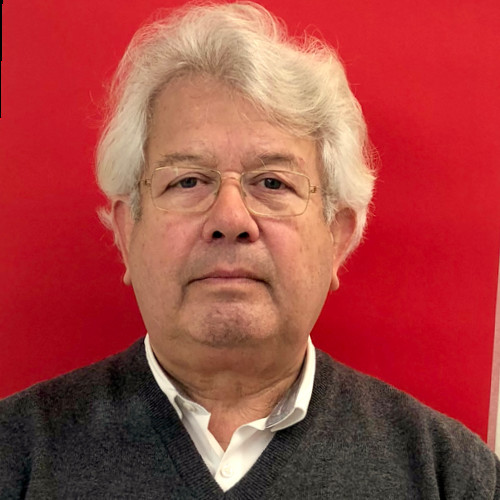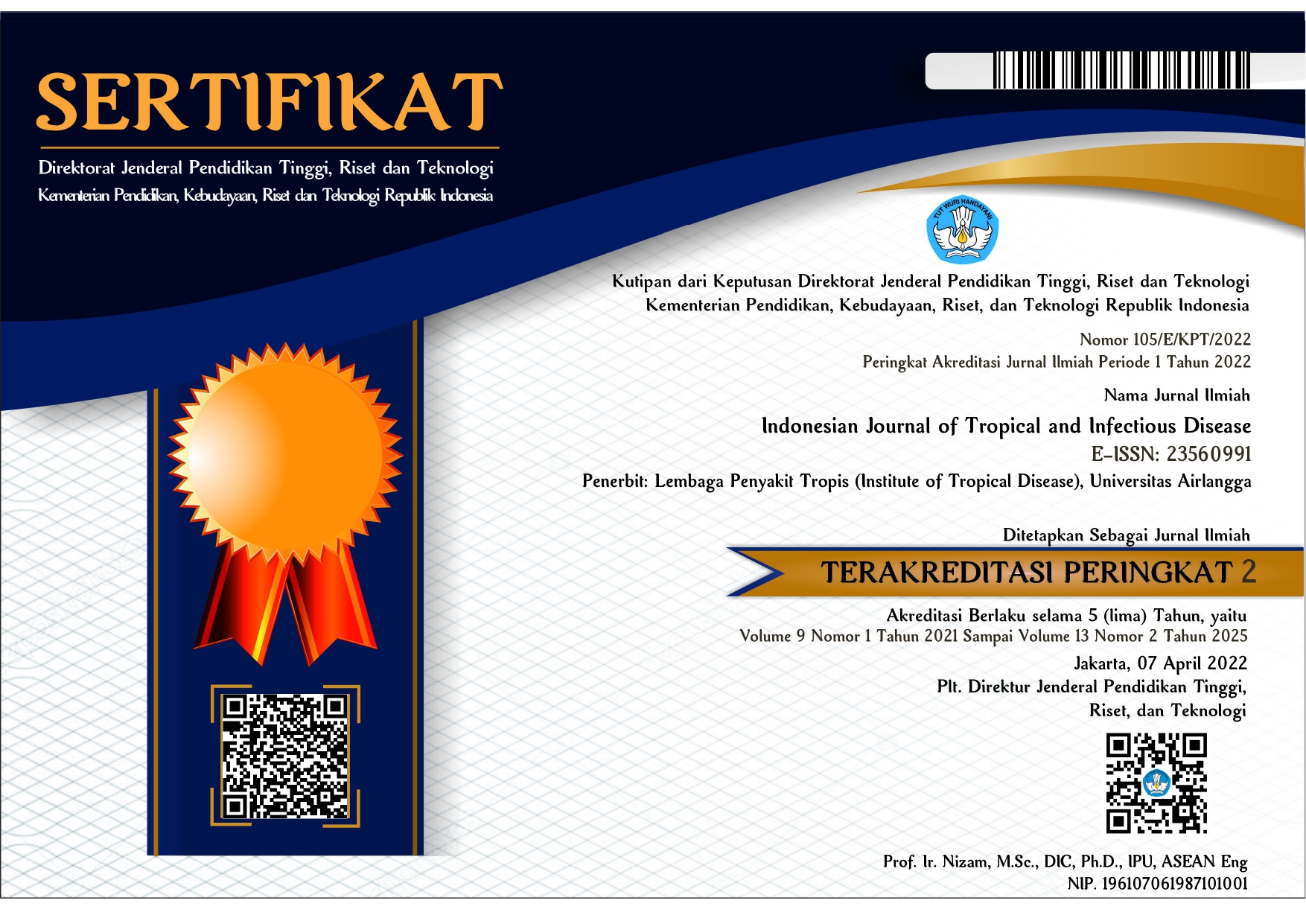Fungemia in Tertiary Hospitals; An Overview Fungal Profile, Antifungal Resistance, and Antifungal Therapy
Downloads
Fungemia is a bloodstream infection caused by fungal pathogen and commonly occurs in hospitalized patients with certain risk factors. Indonesia itself is a tropical country with middle income that makes the incidence rate of fungemia tend to be higher, namely10/1 0,000 people. A recent study about candidemia conducted in Dr. Soetomo General Academic Hospital stated that the most common species that caused candidemia is Candida albicans (33.96%) and the blood sample mostly collected from patients from high care unit and patient with diabetes. We conducted this study to provide a new overview of data on the profile of the causes of fungal infections, patterns of fungal resistance to antifungals, and antifungal therapy in patients with fungemia in hospitalized patients at Dr. Soetomo General Academic Hospital, Surabaya, for the period of January December 2023. This research is a descriptive study using the patient’s medical records. Variables observed in this study include; gender, age, care unit, risk factor, species distribution, resistance pattern, type of antifungal therapy, and duration of antifungal therapy. Mostly the blood cultures are collected from female patients aged 0-9 years old. This study also found that most blood cultures are collected from patients in intensive care unit with use of CVC. Most of the patients did not receive antifungal therapy The most frequent found species is Candida parapsilosis with highest resistance rate found in Amphotericin-B. The most common antifungal that is used is Fluconazole which is mostly given within the range of 8-14 days .
Alejandra L, Cuervo-maldonado SI, Enciso-Olivera JL, et al. Fungemia in Hospitalized Adult Patients with Hematological Malignancies : Epidemiology and Risk Factors. J Fungi (Basel). 2023;9(4):400.
Gaona-Flores VA, Campos-Navarro L, Cervantes-Tovar R, et al. The epidemiology of fungemia in an infectious diseases hospital in mexico city: A 10-year retrospective review. Med Mycol 2016; 54: 600–4.
Fatril AE, Robiatul Adawiyah, Retno Wahyuningsih. Pola Kepekaan Candida krusei Isolat Jakarta terhadap Flukonazol. J Indones Med Assoc 2020; 70: 110–14.
Ayu Pratiwi C, Surya Airlangga P, Dwi Endraswari P. An Overview of Candidemia Patients in Tertiary Hospital, Surabaya, Indonesia. Int J Res Publ 2022; 111: 78–85.
Engelkirk P. Burton’s Microbiology for the Health Sciences 11th edn. 2020.
Adam L, O’Connor C, Garcia AC. Evaluating the Impact of Diabetes Self-Management Education Methods on Knowledge, Attitudes and Behaviours of Adult Patients With Type 2 Diabetes Mellitus. Can J Diabetes 2018; 42: 470-7.e2.
Fisher MC, Alastruey-Izquierdo A, Berman J, et al. Tackling the emerging threat of antifungal resistance to human health. Nat Rev Microbiol 2022; 20: 557–71.
Spellberg B. Vaccines for invasive fungal infections. F1000 Med Rep 2011; 3: 1–8.
Sprute R, Nacov JA, Neofytos D, et al. Antifungal prophylaxis and pre-emptive therapy: When and how? Mol Aspects Med 2023; 92: 101190.
Bouza E, Muñoz P. Epidemiology of candidemia in intensive care units. Int J Antimicrob Agents 2008; 32: 87–91.
Li Y, Du M, Chen LA,, et al. Nosocomial Bloodstream Infection Due to Candida spp. in China: Species Distribution, Clinical Features, and Outcomes. Mycopathologia 2016; 181: 485–95.
Xiao Z, Wang Q, Zhu F, et al. Epidemiology, species distribution, antifungal susceptibility and mortality risk factors of candidemia among critically ill patients: A retrospective study from 2011 to 2017 in a teaching hospital in China. Antimicrob Resist Infect Control 2019; 8: 1–7.
Salehi M, Ghomi Z, Mirshahi R, et al. Epidemiology and outcomes of candidemia in a referral center in Tehran. Casp J Intern Med 2019; 10: 73–9.
Sun M, Chen C, Xiao W, et al. Increase in Candida parapsilosis candidemia in cancer patients. Mediterr J Hematol Infect Dis 2019; 11: 1–7.
Kimura M, Asano-Mori Y, Sakoh T, et al. Factors Associated with Breakthrough Fungemia Caused by Candida, Trichosporon, or Fusarium Species in Patients with Hematological Disorders. Antimicrob Agents Chemother; 66. Epub ahead of print 2022. DOI: 10.1128/aac.02081-21
Pappas PG, Kauffman CA, Andes DR, et al. Clinical Practice Guideline for the Management of Candidiasis: 2016 Update by the Infectious Diseases Society of America. Clin Infect Dis 2015; 62: e1–e50.
Revie NM, Iyer KR, Robbins N, et al. Antifungal drug resistance: evolution, mechanisms and impact. Curr Opin Microbiol 2018; 45: 70–6.
Ding X, Yan D, Sun W, et al. Epidemiology and risk factors for nosocomial Non-Candida albicans candidemia in adult patients at a tertiary care hospital in North China. Med Mycol 2015; 53: 684–90.
Yamin D, Husin A, Harun A. Distribution of candidemia in malaysian tertiary care hospital revealed predominance of candida parapsilosis. Trop Biomed 2020; 37: 903–910.
Lima R, Ribeiro FC, Colombo AL, et al. The emerging threat antifungal-resistant Candida tropicalis in humans, animals, and environment. Front Fungal Biol 2022; 3: 1–11.
Mohanraj H, Vinodhini VM, Vajravelu LK. Mycological Profile of Candida tropicalis and its Virulence Factors from Candidemia Patients at A Tertiary Care Facility. J Pure Appl Microbiol 2023; 17: 982–92.
Taei M, Chadeganipour M, Mohammadi R. An alarming rise of non ‑ albicans Candida species and uncommon yeasts in the clinical samples ; a combination of various molecular techniques for identification of etiologic agents. BMC Res Notes 2019; 1–7.
Bilal H, Shafiq M, Hou B, et al. Distribution and antifungal susceptibility pattern of Candida species from mainland China : A systematic analysis Distribution and antifungal susceptibility pattern of Candida species from mainland China : A systematic analysis. Virulence 2022; 13: 1573–89.
Carolus H, Pierson S, Lagrou K, et al. Amphotericin b and other polyenes—discovery, clinical use, mode of action and drug resistance. J Fungi 2020; 6: 1–20.
Maji A, Soutar CP, Zhang J, et al. Tuning sterol extraction kinetics yields a renal-sparing polyene antifungal. Nature 2023; 623: 1079–85.
Costa-de-oliveira S, Rodrigues AG. Candida albicans antifungal resistance and tolerance in bloodstream infections: The triad yeast-host-antifungal. Microorganisms; 8. Epub ahead of print 2020. DOI: 10.3390/microorganisms8020154.
Logan A, Wolfe A, Williamson JC. Antifungal Resistance and the Role of New Therapeutic Agents. Curr Infect Dis Rep 2022; 24: 105–16.
Nishimoto AT, Sharma C, Rogers PD. Molecular and genetic basis of azole antifungal resistance in the opportunistic pathogenic fungus candida albicans. J Antimicrob Chemother 2020; 75: 257–70.
Yamin D, Akanmu MH, Al Mutair A, et al. Global Prevalence of Antifungal-Resistant Candida parapsilosis: A Systematic Review and Meta-Analysis. Trop Med Infect Dis; 7. Epub ahead of print 2022. DOI: 10.3390/tropicalmed7080188.
Maertens JA, Girmenia C, Brüggemann RJ, et al. European guidelines for primary antifungal prophylaxis in adult haematology patients: Summary of the updated recommendations from the European Conference on Infections in Leukaemia. J Antimicrob Chemother 2018; 73: 3221–30.
Hossain CM, Ryan LK, Gera M, et al. Antifungals and Drug Resistance. Encyclopedia 2022; 2: 1722–37.
Copyright (c) 2025 Indonesian Journal of Tropical and Infectious Disease

This work is licensed under a Creative Commons Attribution-NonCommercial-ShareAlike 4.0 International License.
The Indonesian Journal of Tropical and Infectious Disease (IJTID) is a scientific peer-reviewed journal freely available to be accessed, downloaded, and used for research. All articles published in the IJTID are licensed under the Creative Commons Attribution-NonCommercial-ShareAlike 4.0 International License, which is under the following terms:
Attribution ” You must give appropriate credit, link to the license, and indicate if changes were made. You may do so reasonably, but not in any way that suggests the licensor endorses you or your use.
NonCommercial ” You may not use the material for commercial purposes.
ShareAlike ” If you remix, transform, or build upon the material, you must distribute your contributions under the same license as the original.
No additional restrictions ” You may not apply legal terms or technological measures that legally restrict others from doing anything the license permits.























